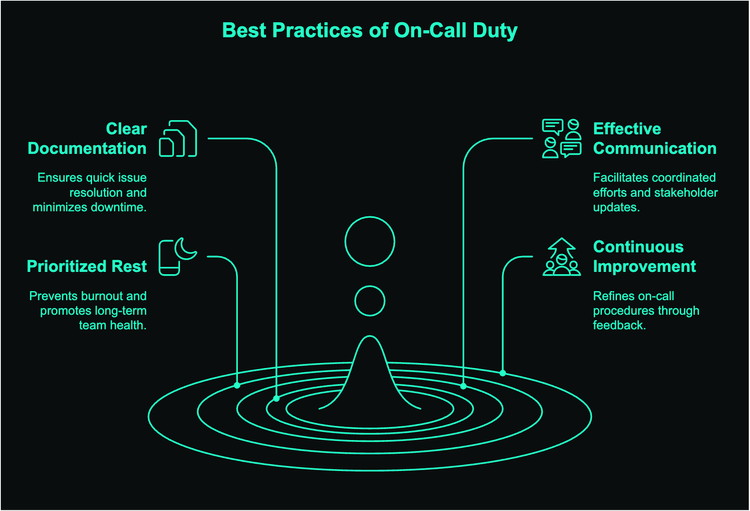Building Effective On-Call Rotations to Maintain Uptime

On-call duties in uptime monitoring can be particularly demanding. The continuous pressure of being available to address urgent issues can significantly impact work-life balance, resulting in burnout and reduced job satisfaction. This affects both individual well-being and system reliability.
However, by implementing on-call rotation schedules, teams can distribute the burden fairly, minimize individual stress, and guarantee consistent coverage for critical systems.
Understanding On-Call Rotations
On-call rotations represent a system where team members take turns being responsible for uptime website monitoring and responding to urgent IT issues outside of regular working hours. This shared responsibility ensures that the burden of on-call duty is not borne solely by a few individuals.
Benefits of On-Call Rotations for Uptime Website Monitoring
Fair Distribution of Responsibilities
On-call rotations ensure that all members of a team contribute to the maintenance of system uptime, preventing any single individual from becoming overburdened. This promotes a sense of shared responsibility across the team.
Improved Work-Life Balance
By distributing on-call duties, teams can minimize the impact on individual work-life balance, allowing for more predictable schedules and reduced stress. This helps employees have a better life outside of work.
Reduced Burnout and Increased Job Satisfaction
By reducing the burden on individual team members, on-call rotations can help prevent burnout, and improve overall job satisfaction, leading to a more positive work environment.
Consistent Coverage and Faster Response Times
With a dedicated on-call team member available at all times, organizations can ensure faster response times to critical issues, which minimizes downtime and its impact on business operations. This responsiveness helps prevent small issues from becoming large ones.
Building Effective On-Call Rotations
Creating effective on-call rotations requires careful planning and consideration:
1. Determine On-Call Coverage Needs
Assess the criticality of your systems and determine the required level of on-call coverage. Consider whether 24/7 coverage is necessary or if weekend coverage is sufficient for your needs, based on the nature of the business.
2. Create a Fair and Equitable Rotation Schedule
Develop a rotation schedule that fairly distributes on-call duties among all team members. Take into account factors such as individual preferences, skill sets, and workloads, to ensure a balanced and equitable distribution. Explore various rotation schedules, such as weekly, bi-weekly, or monthly rotations, to find the best fit for your team. This is important to ensure all team members are comfortable.
3. Establish Clear Communication Channels
Define clear communication channels for on-call alerts, such as phone, email, or instant messaging. Ensure that all team members are aware of these channels, and understand the escalation procedures to follow in the case of an incident. Having clear communication is essential to getting issues resolved quickly.
4. Provide Adequate Support and Resources
Equip on-call personnel with the tools and resources necessary to respond to incidents effectively. This may include remote access to systems, comprehensive documentation, troubleshooting guides, and access to relevant tools and software. Consider providing on-call compensation or other incentives to acknowledge their availability. This helps to ensure that those on-call are comfortable, and feel valued.
5. Conduct Regular Reviews and Adjustments
Regularly review on-call schedules, and gather feedback from team members. This can help to identify any issues, and ensure the system is working as intended. Be prepared to adjust schedules based on changes in workload, team size, or individual preferences, and address any concerns or issues raised by team members regarding the on-call rotation system. This feedback loop is essential to maintain a successful on-call rotation.
Best Practices for On-Call Duty
1. Maintain Clear Documentation
Ensure that all relevant documentation, including runbooks, troubleshooting guides, and contact information, is readily accessible to on-call personnel. This will allow them to quickly resolve issues, and minimize downtime by making resources easily available.
2. Effective Communication During Incidents
Encourage clear and concise communication between on-call personnel, other team members, and stakeholders during incident responses. Use communication channels effectively to provide updates, coordinate efforts, and ensure that all relevant stakeholders are informed of the issue and resolution.
3. Prioritize Rest and Recovery
Emphasize the importance of sufficient rest and recovery time for on-call personnel. Encourage them to prioritize their well-being and avoid burnout, as this is essential to ensuring long-term team health.
4. Continuous Improvement
Regularly review on-call procedures, and gather feedback from team members to identify areas for improvement. This continuous feedback loop will help you refine your on-call rotation strategies, and ensure they are both effective, and sustainable.
How Bubobot can help alleviate the on-call stress
Bubobot offers free uptime monitoring with keyword-based alerting that enables teams to filter out noise and prioritize alerts based on severity and relevance, reducing false alarms and minimizing interruptions.
Moreover, with Bubobot’s escalation policy, teams are ensured that any incident will get resolved as smoothly and fast as possible, keeping your business up and running at all time.
Conclusion
By implementing effective on-call rotation strategies, you can help to ensure consistent uptime, minimize the impact of IT incidents, and create a more sustainable, and fulfilling work environment for your team.
Remember that successful on-call rotations require a balance between operational needs, and the overall well-being of your team. By prioritizing both, you can build a resilient, and high-performing IT team that is well-prepared to handle any challenge.
#OnCallSupport, #UptimeStrategies, #ITTeams